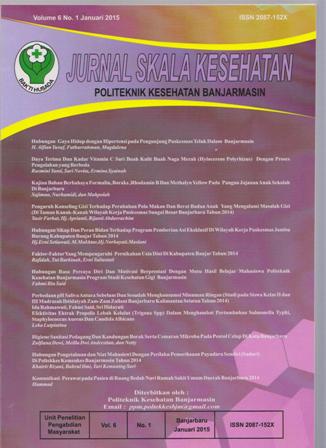DAYA TERIMA DAN KADAR VITAMIN C SARI BUAH KULIT BUAH NAGA MERAH (Hylocereus polyrhizus) DENGAN PROSES PENGOLAHAN YANG BERBEDA
Abstract
Pengolahan kulit buah sampai saat ini masih berkisar pada manisan kering atau basah, selai, teh, dan dodol, serta pembuatan enzim dan pektin dari kulit buah naga. Warna kulit buah yang menawan dan kandungan gizi yang banyak, kulit buah naga juga dapat dibuat produk sari buah. Warna merah suatu sari buah mengindikasikan adanya kandungan antioksidan yang tinggi. Penelitian ini bertujuan mengetahui daya terima dan kadar vitamin C sari buah kulit buah naga merah (Hylocereus polyrhizus) dengan proses pengolahan yang berbeda. Sampel adalah kulit buah naga merah yang diolah menjadi tiga jenis sari buah dengan proses pengolahan yang berbeda yaitu sari buah jernih, sari buah keruh, sari buah pasta. Uji daya terima dilakukan dengan metode hedonic scale dan penentuan kadar vitamin C dengan metode spektrofotometri. Analisis pengaruh daya terima dengan uji Friedmen dan kadar vitamin C dengan One Way Anova. Hasil penelitian menunjukkan terdapat pengaruh proses pengolahan terhadap daya terima warna, aroma dan kekentalan sari buah kulit buah naga merah. Terdapat pengaruh proses pengolahan terhadap kadar vitamin C sari buah kulit buah naga merah. Perlu di lakukan penelitian terhadap proporsi gula dan garam serta daya simpan sari buah kulit buah naga merah. Kata kunci : sari buah, kulit buah naga, daya terima, kadar vitamin C.References
Anonim, 2013. Manfaat Buah Naga Untuk Kecantikan.
http://manfaat-buah-naga-alami.blogspot.com/2013/06/manfaat-buah-naga-untuk-kecantikan.html. Diakses tanggal 14 Pebruari 2014.
Anonim, 2013. Khasiat Buah Naga. http://manfaatnyasehat.blogspot.com/2013/10/kandungan-manfaat-dan-khasiat-buah-naga.html). Diakses tanggal 15 Pebruari 2014
Anonim, 2013. Manfaat Kulit Buah Naga. http://manfaat-buah-segar.blogspot.com/2013/10/manfaat-kulit-buah-naga.html. Diakses tanggal 15 Pebruari 2014
Woo, K. K., F. H. Ngou, L. S. Ngo, W. K. Soong, dan P. Y. Tang. 2011. Stability of Betalain Pigment from Red Dragon Fruit (Hylocereus polyrhizus). American Journal of Food Technology, 6 (2) : 140-148.
Gagung, Joko dan Sunarto. 2012. Pengauh Konsentrasi Gula Terhadap Karakteristik Sirup Buah Naga. Jurnal Pendidikan
http://e-urnalpendidikan.blogspot.com/2012/05/contoh-penelitian-tentang-buah-nga.html
Handayani, Prima Asturi dan Asri Rahmawati. 2012. Pemanfaatan Kulit Buah Naga (Dragon Fruit) Sebagai Pewarna Alami Makanan Pengganti Pewarna Sintetis. Jurnal bahan alam terbarukan.Vol 1, No 2 (2012).
Nogi dan Smoot (1997) dalam Sari Novita (1994). Mempelajari Pengaruh Suhu dan Lama Penyimpanan Terhadap Statistik Vitamin C (Asam askorbat) Pada Produk Minuman Sari Buah Jeruk Kemasan Tetra Pak dan Botol. Skripsi : IPB, Bogor
Kristanto, Daniel. 2008. Buah Naga Pembudidayaan di Pot dan Kebun. Depok : Penebar Swadaya.
Purnomo, Bambang Edi. 2013. Pemanfaatan Kulit Buah Naga Merah (Hylocereus polyrhizus ) Sebagai Teh Berkhasiat
Suprapti, Lies. 1994. Membuat Aneka Olahan Nanas. Puspa Swara
Publishing your paper with JURNAL SKALA KESEHATAN POLITEKNIK KESEHATAN BANJARMASIN (JSK) means that the author or authors retain the copyright in the paper. JSK granted an exclusive reuse license by the author(s), but the author(s) are able to put the paper onto a website, distribute it to colleagues, give it to students, use it in your thesis etc, even commercially. The author(s) can reuse the figures and tables and other information contained in their paper published by JSK in future papers or work without having to ask anyone for permission, provided that the figures, tables or other information that is included in the new paper or work properly references the published paper as the source of the figures, tables or other information, and the new paper or work is not direct at private monetary gain or commercial advantage. JSK journal provides immediate open access to its content on the principle that making research freely available to the public supports a greater global exchange of knowledge. This journal is licensed under a Creative Commons Attribution-ShareAlike 4.0 International License. This license lets others remix, transform, and build upon the material for any purpose, even commercially. JSK journal Open Access articles are distributed under this Creative Commons Attribution-ShareAlike 4.0 International License (CC BY-SA). Articles can be read and shared for All purposes under the following conditions:
BY: You must give appropriate credit, provide a link to the license, and indicate if changes were made. You may do so in any reasonable manner, but not in any way that suggests the licensor endorses you or your use.SA: If you remix, transform, or build upon the material, you must distribute your contributions under the same license as the original.






















